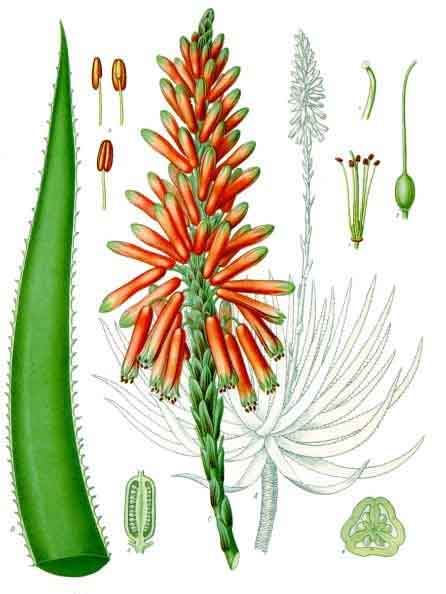|
Aloe succotrina (*)
Aloe, also written Aloë, is a genus containing about four hundred species of flowering succulent plants. The genus is native to Africa, and is common in South Africa's Cape Province, the mountains of tropical Africa, and neighbouring areas such as Madagascar, the Arabian peninsula, and the islands off Africa. The APG II system (2003) placed the genus in the family Asphodelaceae. In the past it has also been assigned to families Aloaceae and Liliaceae. Members of the closely allied genera Gasteria, Haworthia and Kniphofia, which have a similar mode of growth, are also popularly known as aloes. Note that the plant sometimes called "American aloe" (Agave americana) belongs to Agavaceae, a different family. Most Aloes have a rosette of large, thick, fleshy leaves. The leaves are often lance-shaped with a sharp apex and a spiny margin. Aloe flowers are tubular, frequently yellow, pink or red and are borne on densely clustered, simple or branched leafless stems. Many species of Aloe appear to be stemless, with the rosette growing directly at ground level; other varieties may have a branched or unbranched stem from which the fleshy leaves spring. They vary in colour from grey to bright-green and are sometimes striped or mottled. Some aloes native to South Africa have large trunks and are called aloe trees. [1] Uses Aloe species are frequently cultivated as ornamental plants both in gardens and in pots. Many Aloe species are highly decorative and are valued by collectors of succulents. It is claimed to have some medicinal effects, which have been supported by scientific and medical research - see references on article on Aloe Vera. Historical uses Historical use of various Aloe species by humans is well documented, though the species of Aloe used and their clinical effectiveness remain unknown.[2] Of the 300 species of Aloe, only a few were used traditionally as an herbal medicine. This includes aloe perryi (found in northeastern Africa) and aloe ferox (found in South Africa). But the one that tops the list of popularity is aloe vera. It was and still is the most commonly-used type of aloe. The Greeks and Romans used aloe to treat wounds. In the Middle Ages, the yellowish liquid found inside the leaves was favored as a purgative. Some species, in particular Aloe vera are used in alternative medicines and in home first aid. Both the translucent inner pulp and the resinous yellow exudate from wounding the Aloe plant are used externally to relieve skin discomforts. Systematic reviews of randomised and controlled clinical trials have provided no evidence that Aloe vera has a strong medicinal effect.[3][4] Other research however suggests Aloe vera can significantly slow wound healing compared to normal protocols of treatment.[5] Today, the gel found in the leaves is used for soothing minor burns, wounds, and various skin conditions like eczema and ringworm. The use of this herbal medicine was popularized in the 1950s in many Western Countries. The gel's effect is nearly immediate; it also applies a layer over wounds that is said to reduce the chance of any infection.[5] There have been very few properly conducted studies about possible benefits of aloe gel taken internally, since the Aloe extract is toxic, yet, it has been seen, anti-carcinogenic. Data also suggests that components of Aloe inhibit tumor growth.[6] There have been some studies in animal models which indicate that extracts of Aloe have a significant anti-hyperglycemic effect, and may be useful in treating Type II diabetes. These studies have not been confirmed in humans.[7] On May 9, 2002, the U.S. Food and Drug Administration issued a final rule banning the use of aloe and cascara sagrada as laxative ingredients in over-the-counter drug products.[8] Chemical properties Popular culture The aloe plant (A. rubrolutea) occurs as a charge in heraldry, such as in the Civic Heraldry of Namibia.[9] Species * Aloe Vera - used in healthcare & health products Trivia An aloe tree appeared on stamps issued in 1919 by Batum, a semi-autonomous region of Georgia in the South Caucasus region. See also * List of Southern African indigenous trees References 1. ^ Images of aloe trees. External links
Retrieved from "http://en.wikipedia.org/" |
|

